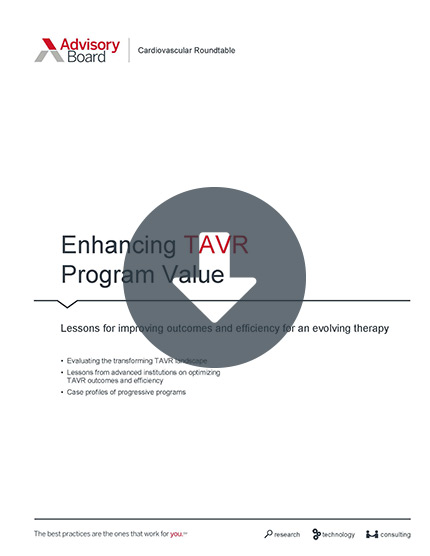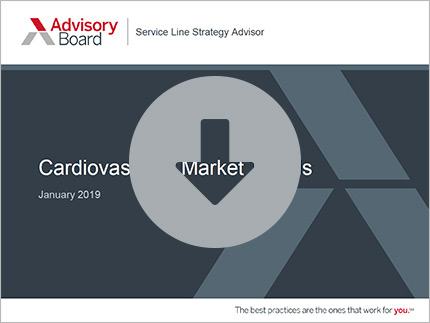Auto logout in seconds.
Continue LogoutRead Advisory Board's take: The takeaways for your CV program
More patients than once expected could potentially benefit from transcatheter aortic valve replacement (TAVR), a less invasive alternative to open-heart surgery, according to two studies published Sunday in the New England Journal of Medicine.
The research could soon lead to a new approach to TAVR backed by FDA, which the New York Times reports is expected to approve the TAVR procedure among patients with lower risks—a shift that could make as many as 20,000 additional patients eligible for the procedure each year.
About TAVR
TAVR currently is FDA-approved for use among patients who cannot have open-heart surgery or patients for whom open-heart surgery is considered risky, such as elderly and frail patients or those with conditions such as kidney or lung disease.
For the procedure, surgeons use a catheter to push aside and replace the old heart valve with a new one. The catheter is threaded through a blood vessel to the patient's heart, making it less invasive than open-heart surgery, which requires the surgeon to crack open the patient's chest. TAVR patients typically can leave the hospital within two or three days, compared with a six-week recovery for open heart surgery.
But the procedure, which is currently available at only about half of the 1,100 U.S. hospitals providing surgical valve replacement, does carry risks, such as stroke, and in some cases could result in patients needing a pacemaker to regulate their heart rhythms. As such, FDA has not yet approved the device for use in low-risk patients.
Research shows TAVR could benefit low-risk patients
But experts say new research is likely to change FDA's position. For the first study, researchers randomly assigned 1,000 patients with severe aortic stenosis and low surgical risks to receive either open-heart surgery or TAVR. The researchers then compared patient outcomes after a one-year period.
The researchers found after one year, patients who underwent open-heart surgery had a 2.9% rate of death or disabling stroke, while patients who underwent TAVR had a 1% rate of death or disabling stroke. Martin Leon, an interventional cardiologist at Columbia University in New York and one of the study's authors, said, "I never could've imagined that even in a low-risk population that we would achieve at one year a 1% death and disabling stroke rate, compared to surgery which was 2.9%. And it was excellent surgery, so this was a surprising finding that was highly statistically significant."
For the second study, researchers randomly assigned 1,403 patients with severe aortic stenosis and low surgical risks to receive either open-heart surgery or TAVR. The researchers then followed up with patients after a two-year period.
The researchers found after two years, patients who underwent TAVR had a 5.3% rate of death or disabling stroke, while patients who underwent open-heart surgery had a 6.7% rate of death or disabling stroke. The researchers also found patients who underwent TAVR spent 2.6 days on average in the hospital, while patient who underwent open-heart surgery spent 6.2 days on average in the hospital.
Based on the study results, two device manufacturers—Edwards Lifesciences and Medtronic—have said they intend to seek FDA approval to allow patients with severe aortic stenosis and low surgical risks to undergo TAVR. According to the New York Times, FDA is expected to approve the use of TAVR among patients with lower risks, which could mean as many as 20,000 additional patients would be eligible for the procedure each year.
Reaction
Robert Lederman, who directs the interventional cardiology research program at the National Heart, Lung and Blood Institute, said the study findings are "remarkable," adding, "Is it important? Heck, yes."
Howard Herrmann, director of interventional cardiology at the University of Pennsylvania, said the research findings "shift our thinking from asking who should get TAVR to why should anyone get surgery."
Herrmann noted hospitals offering the TAVR will experience some financial losses when lower risk patients can begin using the procedure because TAVR valves cost more than the valves for open-heart surgery and insurers typically pay the same amount for either procedure (Kolata, New York Times, 3/16; Allar, Cardiovascular Business, 3/17; Loftus, Wall Street Journal, 3/16).
Advisory Board's take

Megan Tooley, Practice Manager, Cardiovascular Roundtable
Coming on the heels of MitraClip's approval in secondary mitral regurgitation, the results of the low-risk TAVR trials continued an exciting two weeks for structural heart programs. While many were expecting TAVR to be approved in low-risk patients in the coming year, the overwhelmingly positive results in favor of TAVR over surgical aortic valve repair (SAVR) make this almost a sure bet. In fact, the principal investigators went as far as to say that TAVR may become the gold-standard, with surgery reserved for patients ineligible for the transcatheter approach—a complete switch from how TAVR was initially viewed.
While an exciting advance for patients and the cardiovascular community, this indication expansion will also have significant implications on TAVR and non-TAVR programs alike. As I noted with MitraClip, expanding indications for TAVR may strain already capacity-constrained structural heart programs, which will now see much of their remaining aortic valve surgeries switch to TAVR. Programs will need to re-evaluate their coordinator, operator, hybrid lab, and structural heart clinic capacity.
Perhaps the more dramatic impact will be felt by programs that perform surgical aortic valve replacement but not TAVR. We have already seen the majority of SAVR procedures shift to programs that also offer TAVR—what is often referenced as the "halo effect" of offering TAVR. In fact, in 2015, 69% of SAVR were performed at TAVR programs.
As more low-risk surgeries convert to TAVR, it will become even more difficult for non-TAVR programs to meet the surgical volume threshold to begin performing TAVR, even if the new NCD coming out this summer lowers that threshold slightly. Non-TAVR programs will have to carefully evaluate whether they can bolster their volumes enough to become a TAVR program before indication expansion, or risk being locked out of the market.
Regardless, partnership with a TAVR program will be essential to ensure patients have access to the full range of treatment options available to them.
TAVR program requirements are changing, are you ready?
A new expert consensus statement updates requirements for new and existing TAVR programs—and will likely influence CMS' new National Coverage Determination. Get our take on the guidelines, and what they could mean for CV programs.
Don't miss out on the latest Advisory Board insights
Create your free account to access 1 resource, including the latest research and webinars.
Want access without creating an account?
You have 1 free members-only resource remaining this month.
1 free members-only resources remaining
1 free members-only resources remaining
You've reached your limit of free insights
Become a member to access all of Advisory Board's resources, events, and experts
Never miss out on the latest innovative health care content tailored to you.
Benefits include:
You've reached your limit of free insights
Become a member to access all of Advisory Board's resources, events, and experts
Never miss out on the latest innovative health care content tailored to you.
Benefits include:
This content is available through your Curated Research partnership with Advisory Board. Click on ‘view this resource’ to read the full piece
Email ask@advisory.com to learn more
Click on ‘Become a Member’ to learn about the benefits of a Full-Access partnership with Advisory Board
Never miss out on the latest innovative health care content tailored to you.
Benefits Include:
This is for members only. Learn more.
Click on ‘Become a Member’ to learn about the benefits of a Full-Access partnership with Advisory Board
Never miss out on the latest innovative health care content tailored to you.


